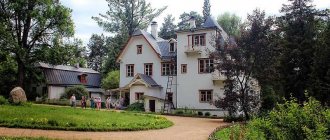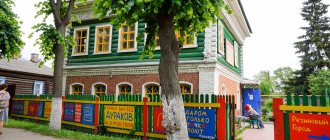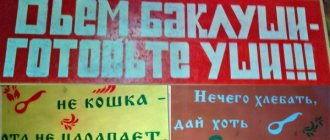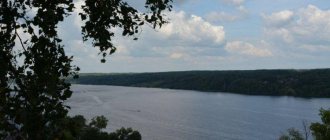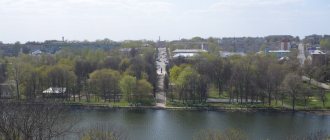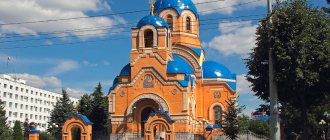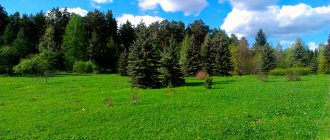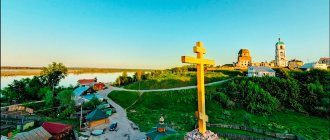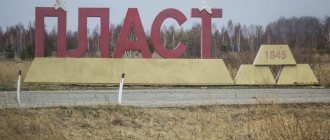Most people associate Tula with gingerbread, a samovar and a savvy flea. Some people remember Yasnaya Polyana and the Museum of Weapons.
Don't be the majority, discover Tula for real. After all, the city has its own university, necropolis, and depot museum. And this is only a small part of the interesting places; no less of them are collected around Tula.
You need to spend several days in Tula to see everything and go to all the museums. Especially if you want to visit all the attractions not only in the city itself, but also in its surroundings - Kulikovo Field, Yasnaya Polyana and more. But if you only have one or two days, our list will help you choose the most interesting.
What is the best way to get to Tula - by train, bus or car?
The most interesting things around Tula are in the overview of the sights of the Tula region.
Historical sites and temples
Tula Kremlin
Address: Tula, st. Mendeleevskaya, 2 Phone: Website: https://museum-tula.ru/muzei/muzej-tulskiy-kreml/ Opening hours: Monday - Thursday, Sunday from 10.00-18.00, Friday and Saturday from 10.00-20.00. The last Wednesday of the month is sanitary day. Cost: Territory - free, see the cost of excursions here.
Here you will see how defense structures were built at the beginning of the 16th century. The Kremlin never surrendered to the enemy and managed to repel all raids. On the territory there are 2 cathedrals, towers that you can climb, gloomy stone cellars with corresponding exhibitions, for example, “Torture”. It houses one of the buildings of the Museum of Weapons. In summer you are allowed to walk along the wall itself.
City Kremlin Garden
Address: st. Mendeleevskaya
Heart of Tula. It was founded a long time ago, in 1837, and now has a well-groomed, pleasant appearance. An excellent place for walking with children - there is a children's playground and an unusual mushroom meadow. The paths are suitable for strollers. From the garden it is a stone's throw to the Kremlin, some museums and churches. It's a good place to freshen up and take a break between sightseeing visits.
Mother of God Shcheglovsky Monastery
Address: st. Liza Chaikina, 1 Phone: Website: https://obitel-tula.narod.ru, https://www.mlekopit.ru Opening hours: Mon-Sat 7:00–19:00; Sun 6:00–19:00
Founded in honor of the Mother of God “Mammal” by the merchant Makarukhin in 1859. Like many monasteries, during Soviet times this monastery was closed, the brethren were disbanded, the utensils were taken away, and the gates were sealed.
Of interest are the main gates with bars. It is made up of geometric shapes. Decorated with medallions with relief images.
Necropolis
Address: Lenin Ave., 31 Phone: Website: https://tiam-tula.ru Opening hours: Tuesday – Friday: 10:00 – 19:00, Saturday, Sunday: 11:00-18:00 Cost: 100 rubles per person from 10 to 17 o'clock, 150 rubles per person from 18 to 23 o'clock
If you like to wander through quiet, mysterious places, be sure to visit one of the cemeteries of the Tula necropolis: Vsekhsvyatskoye, Spaskoye, Chulkovskoye, Judeiskoye. There you will see old, very old graves and monuments, burial places of non-believers and Germans from the time of the war. You will wander along the overgrown paths, listen to the silence and plunge into the depths of our history. Merchants, barons, landowners, factory owners of the Tula province rest in this land.
You can book a tour of one of the cemeteries. They will tell you the history of some of the graves and people buried here. To tickle your nerves, spend an extra 50 rubles and book an evening excursion.
Church of the Annunciation of the Blessed Virgin Mary
Address: Blagoveshchenskaya st., 4 Phone: Website: blagohram.ru Opening hours: 8.00-18.00
The oldest Orthodox church in Tula, built in 1692, is located not far from the Kremlin.
It is interesting as an example of the Moscow style of Russian temple architecture. The bell tower was built simultaneously with the temple and is a striking example of the simplicity and sophistication of traditional Russian architecture.
Assumption Cathedral of the Tula Kremlin
Address: Mendeleevskaya st., 8/2, Tula Kremlin Opening hours: 9.00-22.00
It is located in the center of the Tula Kremlin, being the dominant feature of the entire museum and historical complex. The architectural decoration in the Baroque style gives the building an elegant and festive look.
The cathedral was built in the 18th century on the site of a dilapidated wooden church from the time of Tsar Mikhail Fedorovich. From this temple a massive, almost cubic main building was inherited, which is not at all characteristic of Baroque and Classicism, but is common in ancient Russian architecture.
The cathedral is interesting for its interior paintings, dedicated to gospel stories and ecumenical councils. The wall paintings are designed in a solemn style with monumental paintings and frescoes framed with floral patterns. The images are unique in their clear depiction of the finest details of costumes, hairstyles and jewelry.
All Saints Cathedral
Address: st. Lev Tolstoy, 79 Phone: Website: tulaeparhia.ru Opening hours: 7.00-19.00
It was a small wooden church of the 18th century, which grew into a majestic cathedral. It is of great interest from an architectural point of view: it combines late Baroque and early Russian classicism. Built on a hill, the building rises monumentally above a cemetery with ancient slabs and Gothic-looking crypts. It can be seen from almost all points of the city.
The cathedral houses one of the most revered Orthodox relics - the Kazan Icon of the Mother of God, which was moved here from the Kazan Church destroyed by the Bolsheviks.
There are also particles of the relics of several saints and an image of St. Nicholas the Wonderworker from Athos, with which an interesting legend is associated. The image was kept in the same destroyed Kazan church, and it was miraculously saved after its destruction. The altar girl of the All Saints Cathedral bought the icon for a bottle of vodka from the handymen who were going to use the Orthodox relic on boards to repair the floor.
Historical and architectural monuments
While walking around the flourishing city, whose history goes back centuries, there will undoubtedly be something for connoisseurs of grace and beauty to see. An excursion to the colorful monuments and architectural sights of Tula will bring many vivid emotions.
Estate of I. Liventsov
- Address: st. Dzerzhinsky, 15/7. Transport stop "Dzerzhinsky Street".
Mayor I.V. Liventsov, who owned a luxurious estate built at the turn of the 18th and 19th centuries, bequeathed it to Thule after his death. A stunningly beautiful building with a dome, a lush façade decoration, in the niches of which antique sculptures were placed, was the main architectural pearl of the city of those years. You could enter the estate through the front gate, the arches of which were supported by Doric columns facing Pochtovaya Street, or from Denisovsky Lane, through an equally elegant entrance with attics. Unfortunately, today we can admire only a small part of its former splendor. The main building of the estate, which is in good condition, houses the Children's Art House, but the gates have become dilapidated and are gradually being destroyed. But even in their current form they remain remarkable architectural monuments.
Pyatnitsky Gate Tower
- Address: Entrance to the Kremlin from Metallistov Street. Transport stop "Lenin Square".
One of the most elegant towers of the Tula Kremlin, rising above the swallowtails of the battlements of the fortress wall, protected the entrance to the city from the northwestern side. A square fortification with loopholes is covered by a hipped dome, above which rises another elegant turret, topped with a weather vane. For almost 200 years, royal motorcades, high clergy with their retinue, overseas ambassadors and other honored guests of Tula entered through the gate at the base of the tower, which was then considered a ceremonial gate.
Monument to Lefty
- Address: st. Soviet. Transport stop "Mosina Street".
The bronze monument to the literary hero - the magnificent master Levsha, who, having shown extraordinary talent and Russian ingenuity, managed to outdo the prim English mechanics, was installed on the territory of the Tulmashzavod back in 1989, and 20 years later it took its current place in the city center. A folk craftsman in a blacksmith's apron holds a hammer in one hand and the same flea in the other, as if assessing whether the famous horseshoes fit it. Many Tula residents believe that the prototype of Lefty was A. M. Surnin, who worked for many years at an arms factory and was then appointed its chief mechanic by personal decree of Catherine the Great.
Monument to Peter I
- Address: st. Soviet. Transport stop "Metallistov Street".
The monument to the first Russian emperor was erected in front of one of the brainchildren of Peter I - the Tula Arms Factory. It is interesting that the bronze statue of the Tsar-Reformer, created by the sculptor R. Bach in 1912 for the 200th anniversary of the enterprise, was on the territory of TOZ for a long time and only in 1962 was it put on public display in front of the plant management building. According to the author's plan, Peter the Great appears not as a monarch, but as a simple artisan, not afraid of the hardest work, purposeful, confident in his skill. You will not see such an embodiment of the image of the great emperor anywhere else.
Monument to Leo Tolstoy
- Address: Tolstoy Square. Transport stop "Ulitsa Zhavoronkova".
As you know, the famous Russian writer, whose works are included in the golden fund of world literature, was born in the Tula province. Therefore, there simply could not be a monument to him in the regional center. The monument to the classic appeared in a cozy park with a fountain on Lenin Avenue for a significant date - the 145th anniversary of the birth of L.N. Tolstova. A six-meter bronze sculpture on a massive pedestal trimmed with polished granite depicts the great writer walking through his native land, glorified with inexpressible warmth in many of Lev Nikolaevich’s works.
Sculptural composition “At the samovar”
- Address: Intersection of Puzakova and Oktyabrskaya streets. Transport stop "Moskovskaya Zastava".
In the homeland of Russian samovars there are several monuments dedicated to one of the symbols of Tula. The most beloved by local residents and popular among tourists is the elegant sculpture that greets city guests entering it from Moscow. The composition, cast in bronze, depicts a tea party at a festive table, on which stands a magnificent samovar. A charming city woman listens to the melodic sounds of an accordion played by her friend. A cat and a dog are nestled at the feet of the couple, and Tula gingerbread flaunts between the cups on the table. The free chair and third cup are clearly meant for you. The sculpture seems to emanate peace and warmth.
Don't miss: The most interesting places in Tula region
Museums
Tula State Museum of Weapons
Address: st. Oktyabrskaya, 2. Address in the Kremlin: Tula, Kremlin Telephone: (order excursions), 8 (4872) 30-84-45 (director) Website: https://www.museum-arms.ru Opening hours: Mon-Wed 10.00 — 18.00 (ticket office until 17.00) Thu-Sat 10.00 — 20.00 (ticket office until 19.00) Sun 10.00 — 18.00 (ticket office until 17.00) Both buildings operate in the same mode. Cost: entrance to each exhibition is paid separately and depends on the number of visitors, their age and the order of excursions. See detailed pricing information here.
After samovars and gingerbread, this is the first attraction that comes to mind. Several large exhibitions show the history of various types of weapons - for war and hunting. There are rare collections of small arms and bladed weapons.
You can order excursions and view a map of the museum on the website. The operating hours of parts of the museum may not be the same - it is better to clarify the information a couple of days before your visit. Has another building in the Kremlin.
Tula samovars
Address: st. Mendeleevskaya, 8 Phone: Website: https://www.museum-tula.ru/muzei/muzej-samovar/ Opening hours: Monday - Thursday, Sunday from 10.00-18.00, Friday, Saturday from 10.00-20.00. The last Wednesday of the month is sanitary day. Cost: entrance fee for one person (including the right to amateur photography and video shooting): adult visitors - 250 rubles, pensioners of the Russian Federation - 100 rubles, students (full-time education) - 100 rubles, children under 16 years old - free. See detailed pricing information here.
2 floors and 300 exhibits. Some are in a single copy, you will not see anywhere else: a travel samovar with two taps, a “turnip” samovar, a “watermelon” samovar, “barrel”, “Spider”, and “tulip”. I wonder why they have such names? Take a tour - they will tell you a lot of interesting things and funny stories.
Tula antiquities
Address: Lenin Ave., 47 Telephone: Website: https://www.kulpole.ru Opening hours: daily from 10:00 to 18:00, on Saturdays from 10:00 to 19:00. The last Wednesday of the month is sanitary day. Cost: adult visitors - 80 rubles, students (over 16 years old), pensioners - 60 rubles, youth under 16 years old - free. Excursions: adult visitors 100 rub./per person, pupils/students (over 16 years old), pensioners - 80 rub./per person, youth under 16 years old - 50 rub./per person. See detailed pricing information here
Belongs to the Kulikovo Field museum complex.
An interactive excursion is held in the “Izba” hall, showing the life of our ancestors. You can change into boyar costumes for an additional fee. Color the birds, forge coins - then buy them back. Designed mainly for children.
Museum of Military History of the Tula Region
Address: 1 Metallurgov Ave., 3 Telephone: Website: https://www.museum-tula.ru/muzei/muzej-voenno-istoricheskiy/ Opening hours: Monday - Thursday, Sunday from 10.00-18.00, Friday and Saturday from 10.00 -20.00. The last Wednesday of the month is sanitary day. Cost: entrance fee for one person (including the right to amateur photography and video shooting): adult visitors - 150 rubles, pensioners of the Russian Federation, students (full-time education) - 100 rubles, children under 16 years old - free. Excursion services for one person as part of an excursion group: adult visitors - 250 rubles, schoolchildren, pensioners of the Russian Federation, students (full-time education) - 150 rubles.
A young museum founded in 2002. A collection of items related to the Great Patriotic War of 1982 and 1941-1945, the wars in Afghanistan and Chechnya: costumes, books, notes and diaries, newspapers.
The museum has collected personal belongings of war veterans: items of clothing, combat leaflets, propaganda leaflets, personal numbers, plans of combat operations, flasks, military household items.
Museum "Tula Gingerbread"
Address: Oktyabrskaya st., 45B Telephone: , 49-74-31 Website: oldtula.ru Opening hours: Wed-Sun 09:00-14:00 and 15:00-17:00, weekends: Mon, Tue Cost: from 150 rubles, for groups of 6 people – 900 rubles.
The entire history of Russia, printed in gingerbread. The museum was opened in 1996 in honor of the 850th anniversary of Tula. It contains a unique collection of Tula gingerbreads made in honor of important historical events: from the anniversaries of the Battle of Kulikovo to the coronation of Nicholas II, from the Patriotic War of 1812 to the “Heroic” gingerbread presented to the sailors of the cruiser “Varyag”.
The local collection also tells about the ancient traditions of making and consuming this confectionery product. There is a small shop in the building where you can buy and taste edible souvenirs.
Tula Museum of Fine Arts
Address: st. Friedrich Engels, 64 Phone: , 35-07-33, 35-40-96 Website: tmii-tula.ru Opening hours: Sun, Tue, Wed 10.00-18.00, Thu-Sat 10.00-20.00, closed: Mon Cost: 40 -250 rub.
One of the largest art museums in Russia was opened in 1919. The collection was based on works of art nationalized after the revolution from the Chamber of Antiquities and personal collections of nobles of the Tula province.
From the moment of opening until today, the museum’s collection is constantly replenished with works of domestic and foreign painters and includes paintings by: I.K. Aivazovsky, I.I. Shishkin, I.E. Repin, V.I. Surikov, I.I. Levitan, B. M. Kustodiev, V. A. Serov, V. V. Kandinsky, K. S. Malevich and other famous masters.
What to see in Tula first
Our rating includes those best attractions of Tula that are most popular among local residents and guests of the city. The recommendations are as follows:
Tula Kremlin
The Tula Kremlin is a 16th-century stone fortress in the center of Tula.
A historical and architectural masterpiece of the 16th century. The complex includes buildings such as shopping arcades, a bell tower, the Epiphany and Assumption Cathedrals. You can walk through the Kremlin Garden and the territory of the Tula Kremlin on your own or during a tour, and examine the towers and walls. We advise you to visit the local Weapons Museum and admire the exhibitions in the towers. Such sights of Russia are of interest to travelers of all ages.
Official website: https://tmii-tula.ru
Assumption and Epiphany Cathedrals of the Tula Kremlin
Assumption and Epiphany Cathedrals on the territory of the Tula Kremlin
For Orthodox cathedrals, erected on the Kremlin square. The construction date of the first is the 17th century, the second is the end of the 19th century. Let us note that the Epiphany Church is no longer active; now the Museum of Weapons is open in it.
Official website: https://russian-church.ru
Annunciation Church
Church of the Annunciation of the Blessed Virgin Mary of the 17th century in Tula
One of the most ancient churches in the city, created in the 17th century. The current classical building made of stone replaced the wooden religious building. In the complex of the Annunciation Church there is a main house with five blue bells and a modest bell tower;
Official website: https://blagohram.ru/
Rotunda
Rotunda on the banks of the Upa River with the sights of Tula in the background.
If you want to take incredible photos, your trip to Tula should definitely include a hike to this former observation deck. The rotunda was recently restored. The dark dome is supported by white columns, and musical evenings are often held on the site. The rotunda is located inside a landscaped park.
Tula Weapons Museum
The new building of the Tula State Weapons Museum
At the beginning of the 17th century, weapons production began operating in the city on the orders of Peter 1. But the most beautiful samples never left the factory. Subsequently, Catherine 2 ordered the creation of the “Chamber of Rare Weapons”. Subsequently, its exhibits moved from place to place, and only in 2012 they “settled” in the Epiphany Cathedral in the Museum of Weapons. In the current exhibition halls you can see examples of weapons from the 16th century to the present.
Official website: https://www.museum-arms.ru/
Watch the beautiful views of Tula in this exciting video!
Museum "Tula Samovars"
Museum “Tula Samovars” in a historical building of the early 20th century
Founded in 1990. The first exhibits were delivered here from the literary and historical-architectural museums of the city. The modern exhibition occupies several halls. Samples presented: original souvenir samovars, mini-models received as gifts by the children of the last Russian emperor, as well as medals awarded to master manufacturers at various exhibitions. The whole family should visit such interesting places in Tula.
Official website: https://www.tula-samovar.com
Museum "Tula Gingerbread"
Exposition of the Tula Gingerbread Museum in Tula
Tula gingerbreads are known throughout Russia, which is why local authorities once decided to open an entire museum. Visitors to the complex can learn about the history of the delicacy, which began in the distant 17th century. And also admire the samples created for funerals, weddings, and all kinds of celebrations. There is a store at the museum with a wide range of gingerbread souvenirs. You can attend a master class and prepare a treat with your own hands. Reviews of the visit to the museum are enthusiastic from both children and adults.
Official website: https://www.oldtula.ru
Museum "Moto-Auto-Art"
Motor scooter "Electron", USSR, 1970s of the last century
The exhibition is based on items from Zyakin's private collection (excursions are conducted by him personally). Guests are invited to inspect and get acquainted with the technical features of motorcycle equipment and cars of various brands and models (mainly from a local engineering plant). If you don’t know what to visit in Tula, but are interested in similar topics, you should definitely sign up for an excursion.
Official website: https://moto.tula.ru/
Assumption Cathedral
Tula Holy Assumption Cathedral
An active cathedral church, built in the 18th century (the previous cathedral was made of wood). The current building is a true architectural masterpiece. During the Soviet era, they tried to blow it up, but the attempt was unsuccessful. In the 2000s, large-scale restoration efforts were carried out.
Official website: https://tulaeparhia.ru
All Saints Cathedral
All Saints Cathedral and a three-tier bell tower topped with a high spire.
After the foundation of the cemetery in the 18th century, a stone cathedral was erected on the territory at the expense of Tula merchants. The building had only one level; a second floor appeared later. Relatively recently, the object was recognized as a cultural and historical monument, and its bell tower was restored. Inside there is a great Christian value - the icon of the Kazan Mother of God, painted in the 17th century. During the excursion, guides in Tula will certainly tell the history of this shrine.
Official website: https://tulaeparhia.ru
Tula Museum of Fine Arts
Fountain in front of the entrance to the Tula Museum of Fine Arts.
The collections include paintings that once belonged to aristocratic families. The date of creation of the exhibition is the beginning of the 20th century (the exhibition is expanding). You will be able to see the works of such great Russian masters as Surikov, Serov, Shishkin, etc.
Official website: https://www.tmii-tula.ru/
Museum "Necropolis of the Demidovs"
Nikolo-Zaretsky temple with a bell tower and a monument to Demidov in the historical part of Tula
The Demidovs are in the past world-famous travelers, writers and entrepreneurs involved in industry, mining, etc. The date of creation of the “Necropolis” with the tomb of representatives of the dynasty is 1996. It is best to go on such excursions in Tula with an experienced guide. The accompanying person will tell you the most interesting facts about the place of interest.
Official website: https://www.museum-tula
Tula State Puppet Theater
The main manor house of the late 18th century, later the zemstvo council, now the Tula Puppet Theater
Just like many other attractions of Tula, this one is created for guests of all ages. The theater hosts performances not only for children, but also for adults. The list of productions is updated regularly.
Tula State Circus
The main facade of the Tula State Circus
The establishment was opened in 1963. Over many years of successful history, such legends of the circus world as acrobats A. Bondareva, M. Zapashny with his tigers, illusionist Kio, Yu. Nikulin and M. Rumyantsev have visited its stage. If you don’t know where to go in Tula with your child, go to the circus.
Official website: https://circus-tula.ru/
Tula Exotarium
Statue of a tyrannosaurus at the entrance to the Tula Exotarium
Opening date: 1987, the first inhabitants were a hundred different animals. Nowadays, the exotarium contains mainly reptiles (the number of snakes is especially large). A dinosaur was chosen as the symbol of the establishment. You can walk through the halls and look at their “inhabitants” as part of a tour group or on your own. Thematic meetings and temporary exhibitions are held.
Official website: https://www.tulazoo.ru/
Museum "Old Tula Pharmacy"
Antique apothecary utensils
Do you want to know what a real pharmacy looked like in the 18th century? Then come to this museum and look at the spacious sales area with mirrored cabinets and numerous medicines. The samples of medicines, prescription forms, pharmaceutical utensils and instruments presented here will arouse your interest, even if you are not interested in medicine itself. The showcases are thematic, one is dedicated to medical miracles (with such outlandish specimens as a human skull, fish entrails, snakes preserved in alcohol), another to the work of pharmacists, a third to the production of medicines, a fourth to herbal treatment, etc. You can become a spectator of the excursion program or a direct participant in a master class (for example, on making perfumes from natural oils).
Museum "Harmony of Grandfather Philemon"
Bayan of the Tula Music Factory of the last century
The exhibition includes over a hundred samples. Each musical instrument is special and unique, each has its own history. Accordions, accordions, harmonicas and button accordions have arrived and continue to arrive at the museum from Nizhny Novgorod, Yelets, Saratov and many other Russian cities. There are both circus and variety instruments, as well as “home” models of instruments. Guests are offered not only a tour of the exhibition, but also a real concert with the participation of samples. During the excursions there are dances and games.
Official website: https://www.harmonic-museum.ru/
Monument to Lefty
The Bronze Monument to Lefty is a symbol of the skill and hard work of the Tula people.
The monument was created in 1989 in honor of the talented Tula gunsmiths. The monument was opened to mark the 50th anniversary of local engineering production.
Monument to Tula gingerbread
A popular place for memorable photographs at the monument to the Tula gingerbread
Another unusual 2-meter monument made of bronze. Construction date: 2014. Location – not far from the Registry Office. The weight of a round gingerbread is about 1.3 thousand kg. If you don’t know what to see in Tula in 1 day and want to see objects associated with the traditions of the city, come here.
Central Park of Culture and Leisure named after. Belousova
Panorama of the territory of the Central Park of Culture and Leisure named after.
Belousova in Tula The park complex is located in the central part of the city. A generally recognized national treasure, it is included in the TOP 10 largest European parks. The territory is distributed as follows: 35 hectares - recreation areas, 11 hectares - three reservoirs with water bodies, 97 hectares - forests (total area of the complex is 143 hectares). The park contains numerous trees (including such less common species as white willow, red oak, Siberian cedar, etc.), shrubs, herbs and flowers. While walking, you can meet the “locals”: wild ducks and other birds, squirrels. Animals and birds are not afraid of people, happily accepting food from their hands.
Official website: https://tulskieparki.ru
Entertainment
Exotarium
Address: st. Oktyabrskaya, 26 (old building), Belousov PKIO, bldg. 10 next to the Green Planet globe (new building). Phone: (old building), 8(4872)770-118 (new building) Website: https://tulazoo.ru Opening hours: Mon, Tue 12:00–18:00; Wed-Sun 10:00–18:00 Cost: prices for tickets and excursions here
The inhabitants of the Exotarium are snakes, frogs, fish, amphibians, and birds. If you're lucky, you'll see shed snake skin. Or feeding frogs. Or maybe you’ll get to one of the exhibitions on the museum’s territory.
Experimentation: a museum of entertaining sciences for adults and children
Address: Lenina Ave., 85, “Likerka Loft”, 2nd floor Telephone: +7 (4872) 770 - 213, +7 (961) 260-53-68 Website: https://experimentoria.ru Opening hours: from 10 :00-20:00 seven days a week Cost: children under 3 years old free, children over 3 years old and adults over 18 years old - 350 rubles. Family (2 adults + 2 children) - 1,250 rubles . Planetarium : children under 3 years old free, single ticket over 3 years old - 100 rubles. Family (2 adults + 2 children) - 350 rub. Show from 1500 rub. Disabled people and large families get a 50% discount, pensioners get a 20% discount, and students get a ticket for 200 rubles.
Another museum for children. The exhibits clearly demonstrate scientific laws in action. You can touch, feel, and turn everything in your hands. Take part in an experiment and perhaps discover a new law.
There is a planetarium where films are shown. Children's parties are held.
Touching Zoo
Address: st. Zhavoronkova, 5 Phone: Website: vk.com/71zoo Opening hours: 10.00-20.00 Cost: 150-200 rub.
A small zoo with exotic and domestic animals, many of which you can touch and feed.
Among the inhabitants of the zoo: raccoons, meerkats, hedgehogs, noses, chinchillas, turtles, monkeys, squirrels and other representatives of the animal world. You can buy a glass of chopped fruit and feed it to the animals, even climb into the enclosure of rabbits and guinea pigs.
During this time, zoo staff will tell you about the characteristics of different animals, for example, where red-handed tamarins are found and what the noses eat.
Malakhovo
Address: pos. Malakhovo Coordinates: 54.35521 37.50632 Phone: Website: malakhovo.ru Opening hours: Mon-Fri 15.00-23.00, Sat-Sun 10.00-23.00 Cost: six-hour subscription - 900/1300 rubles. (weekdays/weekends); ski or snowboard rental for the day - 1500/1900 rubles. – for adults, for children prices are half as low. Instructor services from 700 rub. How to get there: follow the Tula-Belgorod highway to the Malakhovo-Slobodka intersection, turn right and drive about 1.5 km to the Malakhovo cottage village
A wonderful holiday destination for winter sports lovers. The ski resort is located near Tula and 140 km from Moscow. The complex has 9 trails of various difficulty levels with three lifts, as well as a free skating rink, a cafe and parking lots.
An advanced snowmaking system has been installed in Malakhovo, which allows you to start the season before the arrival of snowfalls and significantly extend it in the spring. Artificial snow generators and snowcats maintain the condition of the slopes at an excellent level, restoring the snow cover daily.
Rescue workers are constantly present on the slopes, and a first aid station operates to provide medical assistance.
Beautiful temples of Tula
The cathedrals and churches of Tula amaze with the splendor of their architecture. Many of them have the status of historical monuments, being excellent examples of ancient Russian church architecture.
Temple of the Twelve Apostles
- Opening hours: daily, from 8:00 to 19:00.
- Phone: +.
- Address: st. Oboronnaya, 92. Transport stop “Kaulya Street”.
The temple, consecrated in 1909, the construction of which was carried out at the expense of the famous Tula confectioner V. Serikov, is especially revered by Tula residents, because services there did not stop even during the years of universal atheism. The five-domed red brick church with a blue main dome, surrounded by a lace arch made of snow-white limestone, looks incredibly elegant. The niches of its facades are decorated with magnificent frescoes, and the carved iconostasis of the altar glitters with gilding. The main relics of the temple are considered to be the icons of “Mother of God of Tikhvin”, “St. Nicholas”, “Passionate Savior” and “Assumption of the Virgin Mary”.
Church of the Ascension
- Opening hours: daily, from 7:00 to 19:00.
- Telephone.
- Address: st. Herzen, 12/3. Transport stop "Sacco and Vanzetti Street".
The remarkable single-domed church with an elegant gilded dome on a two-tier drum stands out clearly from the surrounding buildings. The architecture of the temple, which took almost 13 years to build and was consecrated in 1787, embodies the best traditions of Russian church baroque. Despite its overall massiveness, it looks very lightweight. There have been many tragic moments in the long history of the church. The gilded iconostasis, painted by G. Belousov, was destroyed by fire in 1834. Already during the years of Soviet power, the magnificent bell tower was destroyed, and warehouses were built in the church premises. Prayers began again under its arches in 1992. The icon of the “Ascension” and the image of “Nicholas the Wonderworker” are considered the temple shrines.
All Saints Cathedral
- Opening hours: daily, from 7:00 to 19:00.
- Telephone.
- Website: https://tulaeparhia.ru/prixodyi/g.tula/vsexsvyatskij-kafedralnyij-sobor-g.-tulyi
- Address: st. Lev Tolstoy, 79. Transport stop “Pervomaiskaya Street”.
The history of the construction of the cathedral is extremely interesting. Initially, it was a one-story stone church, over which a second tier was erected in 1788. However, two years later the main dome collapsed after the evening liturgy. The reconstruction of the building took 7 years, but even after its completion the temple was not consecrated until 1825. The cathedral attracts with its original architecture, which is a mixture of classics and baroque. The main feature of the exterior is the absence of a traditional drum under the central gilded onion. On the elegant bell tower of the temple, decorated with sculptures of angels, the largest bell in Tula weighing more than 16 tons is installed. The main relic of the temple is the icon of the “Mother of God of Kazan”.
Streets and architecture
To better understand the city and feel its atmosphere, walk along the central streets of Tula: Oktyabrskaya, Mendeleevskaya, Lenin Avenue.
Among the bustle of the city and traffic jams, you will see ancient houses - architectural monuments: the Gostiny Dvor building, the police building, the samovar factory, apartment buildings. Not all have been restored, and some are neglected. Most have changed their purpose, are used for the needs of the city and look fresh and beautiful.
Mendeleevskaya street
Lenin Avenue
Finally, a video tour of Tula:
Neighborhoods of Tula
Kulikovo field
Website: https://www.kulpole.ru Museum complex "Kulikovo Pole" Address: Tula region, Kurkinsky district, Mokhovoye Phone: (48743)4-36-01 Opening hours : - summer time (April 15 - October 14) from 10.00 to 19.00, seven days a week, sanitary day - the last Monday of the month; - winter opening hours (November 15 - March 14) from 10.00 to 16.00, day off - Tuesday, sanitary day - the last Monday of the month; - off-season opening hours (March 15 - April 14, October 15 - November 14) from 10.00 to 17.00, day off - Tuesday, sanitary day - the last Monday of the month. Cost : 150 rubles for adults, students (over 16 years old), pensioners - 100 rubles, youth under 16 years old free.
Memorial on the Red Hill of the Kulikovo Field Address: Tula region, Kurkinsky district, Ivanovka village Telephone: (48743) 3-12-44 Opening hours : according to the seasons, like the Museum complex “Kulikovo Field” Cost : excursion 200 rubles. per person, group up to 5 people, 350 rub. per person, group up to 15 people, 750 rub. per person, group 750 people. Excursion with radio guide 250/600/1200 respectively.
Museum-memorial complex in the village of Monastyrshchino Address: Tula region, Kimovsky district, village of Monastyrshchino Telephone: (48735) 3-15-46 Opening hours : by season, like the Museum complex “Kulikovo Field” Cost : 150 rubles. adult, students (over 16 years old), pensioners - 100 rubles, youth under 16 years old free. Excursions from 200 rubles. Additional services from 10 rub.
Museum of Merchant Life in the village of Epifan Address: Tula region, Kimovsky district, Epifan village, Kimovskaya str., 8 Telephone: (48735) 7-22-65 Opening hours : winter period (October 15 - April 14): from 10.00 to 17.00 , day off - Tuesday, sanitary day - last Monday of the month; summer period (April 15 - October 14): from 10.00 to 17.00 (Sunday-Thursday), from 10.00 to 18.00 (Friday - Saturday and holidays), seven days a week, sanitary day is the last Monday of the month. Cost : 100 rubles/per person, pensioners, pupils/students (over 16 years old) - 80 rubles/per person, persons under 16 years old - free. Excursions from 70 rubles per person - depends on the topic and route. Interactive programs for a group of 5 people - from 100 rubles.
The easiest way to get to the place where the famous Battle of Kulikovo took place is to book a tour on the museum’s website.
If you want to get there on your own, no problem, the museum staff has taken care of you: there is a map and signs at the entrance to the battlefield. To avoid getting lost on the road, go to the museum’s website in the “Excursions” section - “Driving directions to Kulikovo Field.” There you will see a map with the route, bus schedules from Tula, Moscow and Kimovsk.
The reserve includes 5 attractions:
- Directly the battlefield , where in 1380 Russian and Golden Horde troops clashed. Relics from that era are still found here. But if you are not a professional treasure hunter, you will see just an ordinary field.
- The Kulikovo Field museum complex is located next to the battlefield, where the exhibition “The Legend of the Massacre of Mamayev” is currently open. A new reading.”Here the history of the battle is shown from two sides. First, the story about the battle of 1380 is based on the “Tale of the Massacre of Mamaev.” The chronicle history is supported by authentic evidence of the Battle of Kulikovo - finds of archaeologists discovered by researchers on the battlefield. The second part is the reconstruction of the historical landscape of the 14th century, which helped determine the forest and steppe territories and the site of the battle, the archeology of the Kulikovo field and the search for relics of the Battle of Kulikovo, the burial places of fallen soldiers, recreated pictures of life in the ancient settlements of the Kulikovo field. The central exhibit is the main model of the Kulikovo battlefield. In a special pyramid showcase, the landscape of the 14th century is reconstructed and a chronicle of the events of September 7 and 8 is presented - from the crossing of the Russian army across the Don to the moment of the fierce battle in which the Ambush Regiment is about to enter.
- The village of Monastyrshchino with the Green Oak Forest , where the Russian Ambush Regiment waited for the hour of victory, turning the tide of the battle in our direction at the right moment and giving us our first victory. Fallen Russian soldiers are also buried here.
- The memorial on Red Hill is the monument to Dmitry Donskoy, preserved from 1880, and the Church of St. Sergius of Radonezh.
- The village of Epifan is a museum of the life of Russian merchants and philistines. You will see the living room, the office of the owner - the merchant, the kitchen, the women's half of the house, and, of course, the merchant's shop with a basement - warehouse.
Yasnaya Polyana
Address: Tula region, Shchekinsky district, Yasnaya Polyana village. Telephone: Excursion department: 8 (48751) 76-1-25 Website: https://ypmuseum.ru/ru Opening hours: Entrance to the territory of the reserve is carried out daily with entrance tickets
- From November 1 to March 31, entrance is from 9:00 to 17:00, you can stay on site until 18:00
- From April 1 to October 31, entrance is from 9:00 to 20:00, you can stay on the territory until 21:00
Visiting memorial buildings – from 10:00 to 15:30
- From April 1 to October 31, on Saturday and Sunday, visiting memorial buildings from 10:00 to 16:30
Excursions - from 9:30 to 15:30
- From May 8 to October 31, on Saturday and Sunday, excursions are held from 9:30 to 16:30
Closed on Monday. Sanitary day in the Tolstoy House - the last Tuesday of the month Sanitary day in the Kuzminskikh Wing - the last Wednesday of the month Cost: from 250 rubles per adult on weekdays, from 300 on weekends (with excursion service) get to the complex by car along the M2 "Crimea" highway ", as well as leaving Tula through the street. Oktyabrskaya. Buses run from Moscow and Tula. See detailed travel options here.
The famous estate of Leo Tolstoy. Here he was born, married and wrote his masterpieces. His house and outbuildings are presented. The house contains a collection of personal belongings, and the life-time furnishings have been preserved as much as possible. The pride of the museum is 22 thousand books.
To learn more about the life of Lev Nikolaevich, his family relationships and social activities, it is worth booking a tour. Afterwards, you can wander through the park alleys, buy a painting of natural beauty, have a snack and buy souvenirs.
Mother of God Nativity Convent
Address: Tula region, pos. Burners, st. Mirnaya, 17B Telephone: Website: https://inokini-tula.ru Opening hours: liturgy at 08:00, evening service at 16:00
The wooden temple, on the site of which the monastery now stands, existed back in the 15th century. Stone - consecrated in 1783. It existed before Soviet times, was destroyed and served as a film warehouse. It has a close connection with the Shcheglovsky Monastery of the Mother of God - it was there that the male monks were resettled, and the Mother of God Nativity Monastery became a women's monastery.
The revered shrine is the icon of the Tikhvin Mother of God.
You can get to the monastery by car. Detailed map of travel from Tula and around the village. Burners - on the monastery website.
Polenovo
Address: Zaoksky district, Strakhovo village Phone: +7 (48734) 3-38-38, +7 (906) 702-57-52 Website: polenovo.ru Opening hours: Wed-Sun 11.00-18.00, weekends: Mon, Tue , closed in April for cleaning Cost: 150-300 rubles, organized excursions with boat rides from 1300 rubles. How to get there: from Tula along the M2 “Crimea” highway, drive 45 km to the exit towards Staro-Simferopol Highway, turn right and drive 2.1 km to Malakhovo. In Malakhovo, turn left at the sign “Polenovo” and then follow the main road for 9.6 km until turning right at the sign “Polenovo” for 3.6 km.
The estate was built on the picturesque banks of the Oka River at the end of the 19th century by the artist Vasily Polenov. He first saw these places from the train windows and subsequently returned here more than once: he fell in love with the local nature so much.
Almost everything on the territory of the estate was created by Polenov: he designed the Main House, the Admiralty, the Abbey, the Trinity Church and other buildings. He even personally looked after the garden and planted trees that are still alive today.
But the artist’s plan was much larger than just creating a well-kept estate for his family: he wanted to reveal the beauty of these places to people. Polenovo was originally conceived as a museum and park complex, open to all segments of society, and very soon the estate became the cultural center of the province. Exhibitions and performances were held here, and representatives of the intelligentsia liked to come here.
Polenovo has been preserved practically unchanged, which allows you to feel the spirit of a noble estate of the 19th century, just like in the books of Russian classics.
The descendants of Vasily Polenov still take care of the estate: his great-granddaughter Natalya works as the head of the museum.
Bogoroditsky Palace-Museum and Park
Address: Bogoroditsk, A. T. Bolotov Park, 1 Phone: +7 (48761) 2-25-32 Website: museum-tula.ru Opening hours: Sun, Tue, Wed 10.00-18.00, Thu-Sat 10.00-20.00 Cost: 200 rub. How to get there: Bogoroditsk, 70 km from Tula
Palace and park complex in the city of Bogoroditsk near Tula. According to legend, Count A.G. Bobrinsky was able to acquire such a luxurious palace because he was the illegitimate son of Catherine the Great.
The estate was plundered several times during periods of wars and revolutions. And although its best years are already behind it, the interior of the main building is of great historical and cultural interest: the museum staff have done a great job of restoring the heritage of the 18th century. The Palace Museum introduces visitors to the culture of early Russian classicism.
The estate is the center of Bogoroditsk: five main streets of the city begin from it. Nearby there is a pond, in the clear water of which you can see the facade of the “Tula Peterhof”, as they like to call it for the scale of its architectural design.
Source of the Don
Address: Novomoskovsk, Children's Park, opposite the Voskhod shopping center (Komsomolskaya, 6A) Opening hours: 24 hours How to get there: Novomoskovsk, 60 km from Tula
The monument was opened in 2000 and is a huge boulder with a spring gushing out from under it, and a little to the side is the sculpture “Shat and Don”: two horses with two brothers.
The sculpture refers to Leo Tolstoy’s fairy tale, in which one of the brothers traveled a long way and, being strong in character, became a great river, while the other brother, twisting and turning, walked his path to no avail and sank into oblivion.
According to local residents, the Source of the Don regularly stops its flow due to maintenance, which, however, does not negate its important symbolic meaning: the great river really begins in these parts from many local streams, so the exact location of the source is impossible to determine.
Sights of Tula: what else to visit in Tula?
We told you about the main attractions of Tula briefly. If you decide to continue your exploration of the city, visit sites such as:
Bogoroditsky Palace-Museum and Park
The former estate of the Bobrinsky counts surrounded by a picturesque park.
The museum in the palace of the Bobrinsky count family was built during Soviet times in 1918. The modern museum is historical and artistic. You should examine not only its exhibitions, but also the house itself and the adjacent park area. Even the best hotels in Tula are not as luxurious as the main building of the complex.
Official website: https://palace-museum-park.org/
Polenovo Estate-Museum
The facade of a large house in the Polenovo estate museum
V. Polenov is a famous Russian painter, whose mansion with a park and flower beds has survived to this day in excellent condition. The complex owned by the artist today includes: the exhibition hall City of Masters, the Admiralty (a place where ships are stored), a workshop-abbey, as well as the main building, which houses the artist’s paintings and personal belongings. Please note that you must purchase a separate ticket to view each building.
Official website: https://www.polenovo.ru/ru
Kulikovo field
Monument to Dmitry Donskoy on the Kulikovo Field
Each of us has heard about this landmark since childhood. To this day, it is possible to find weapons, elements of armor and crosses here. In the 17th century, the village of Monastyrshchino was founded on the territory, but two centuries later they decided to make the square also a monument to fallen wars, installing several sculptures (S. Radonezhsky and D. Donskoy), and the Cathedral of the Virgin Mary. In 1960, the city's local history museum was built here.
Official website: https://www.kulpole.ru/
Yasnaya Polyana
Yasnaya Polyana is the family estate of the great Russian writer Leo Nikolaevich Tolstoy.
Now Yasnaya Polyana is home to a house museum, visited by guests from all over Russia. Previously, L. Tolstoy lived in this building, and then his family. The museum complex in the house was created only in 1921. By the way, it was in Yasnaya Polyana that the author managed to write the greatest of his books (he was buried here).
Official website: https://ypmuseum.ru/
